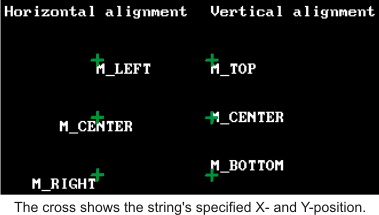Writing text
- See also

 Availability
Availability 
 Previous
Previous
- Next

-
Background mode. This determines whether to fill the background of the text. The default is to fill the background. To change the default (for example, to make it transparent), use MgraControl() with M_BACKGROUND_MODE.
-
Background color. This determines the color used behind text. The default background color value is zero (typically corresponds to black). To change the default, use MgraControl() with M_BACKCOLOR or MgraBackColor().
-
Font. This determines the text's font. You can choose between a bitmap font, or a TrueType font installed on your computer. To change the text font, use MgraFont().
You can specify a TrueType font using MgraFont() with the MIL_FONT_NAME() macro. You can specify to use the default TrueType font of your operating system by passing M_FONT_DEFAULT_TTF to the macro, or you can specify a font and style by passing a MIL_TEXT string according to the following format: Family: Weight: Slant (for example, " Arial: Bold: Italic "). You can also pass the MIL_FONT_NAME() macro a MIL_TEXT string with the path to a TrueType font file (for example, "C:\myDirectory\myTrueTypeFont.ttf "). If a specified TrueType font does not support a character code that needs to be drawn, you can have MIL search for a suitable font to draw the character using MgraControl() with M_FONT_AUTO_SELECT.
You can specify the size of TrueType fonts using MgraControl() with M_FONT_SIZE.
With bitmap fonts, it is not possible to specify an exact font size other than the three provided default sizes (M_FONT_DEFAULT_LARGE, M_FONT_DEFAULT_MEDIUM, and M_FONT_DEFAULT_SMALL). However, using MgraControl() with M_FONT_X_SCALE and M_FONT_Y_SCALE, or MgraFontScale(), you can scale any of the three default bitmap sizes to a more suitable size.
-
Horizontal and vertical alignment. This determines the alignment of the text in the horizontal and vertical direction. The defaults are left-aligned and top-aligned, with respect to the string's specified X- and Y-position. To change the defaults, use MgraControl() with M_TEXT_ALIGN_HORIZONTAL and M_TEXT_ALIGN_VERTICAL.

-
Text border. This allows you to draw a border around the block of text that you want to print. You can draw a border above, below, to the left, or to the right of the text, or any combination of the four directions. The default is to draw no borders. To change the defaults, use MgraControl() with M_TEXT_BORDER.
-
Text direction. This allows you to specify the direction to draw the text. The default is to draw the text from left to right. To change the defaults, use MgraControl() with M_TEXT_DIRECTION.
To perform text annotations, use MgraText(), which writes a string at the specified position in a given buffer. The position is interpreted according to the specified units and associated coordinate system set using MgraControl() with M_INPUT_UNITS.
MgraText() can also add text to a 2D graphics list. For more information, see the 2D graphics list section later in this chapter.
Text is drawn using the current foreground color of the 2D graphics context. The 2D graphics context also assigns the following settings to text:
For an example of how to perform multiple text annotations with differing fonts, see: